
Introduction
The pandemic has exacerbated long standing social and economic injustices perpetrated on marginalized communities, drawing attention to disparities in health care, education, and economic opportunity. While many K-12 and higher education institutions had made efforts to close opportunity gaps and improve access to postsecondary options, much of the progress and gains witnessed over the last few decades disappeared during the pandemic. Across the nation, we’ve seen the significant decline in college enrollment for first time freshmen as well as the disengagement of current college students that further sets back any modern efforts to support students holistically. At San Diego State University’s Center for Equity and Postsecondary Attainment, a team of researchers and practitioners set out to learn and listen to students in their senior year of high school, a critical transition point to postsecondary education.
We believe we are seeing evidence of a generational shift in young people’s attitudes towards postsecondary education and the need for schools (both K-12 and higher education) to re-think how models are built to adapt to students today. Specifically, students are reporting a reluctance to take out debt to pay for college, concern about employment opportunities, and an interest in exploring multiple pathways concurrently. This report shares the students' voices and is intended to guide the development of responsive strategies and provide opportunities to redefine how we support students in their postsecondary planning.
Key Findings
![]()
28% of respondents report that COVID19 has had a significant impact on their postsecondary plans. And echoing many national surveys, 55% of students reported they missed at least ONE college and career activity due to the pandemic.
![]()
Students are opening up to MANY POSSIBILITIES and don't see their postsecondary plans as a singular option- 32% selected at least two postsecondary pathways.
![]()
Students are questioning the value proposition of college and reject the idea that they must accumulate large amounts of debt to pursue postsecondary education. Only 27% of survey respondents believe they will use loans to pay for postsecondary education, compared to national data where 43% of college attendees report that they incurred some type of educational debt.
![]()
Students across all academic levels reported that “Completing courses so that I can graduate” was their most urgent need.
![]()
During the pandemic students reported that a wide variety of staff members were "always" available to them! As we consider the adults who support postsecondary planning, there is an opportunity to open the doors to include a broader group of school based and support staff to provide robust support to students.
![]()
A qualitative study was completed on the final question “What do you wish adults knew about the high school experience that might help them to do their job better?” Mental health and stress were the most common answers.
Survey Sample
1162 Class of 2022 seniors are included in the analysis.
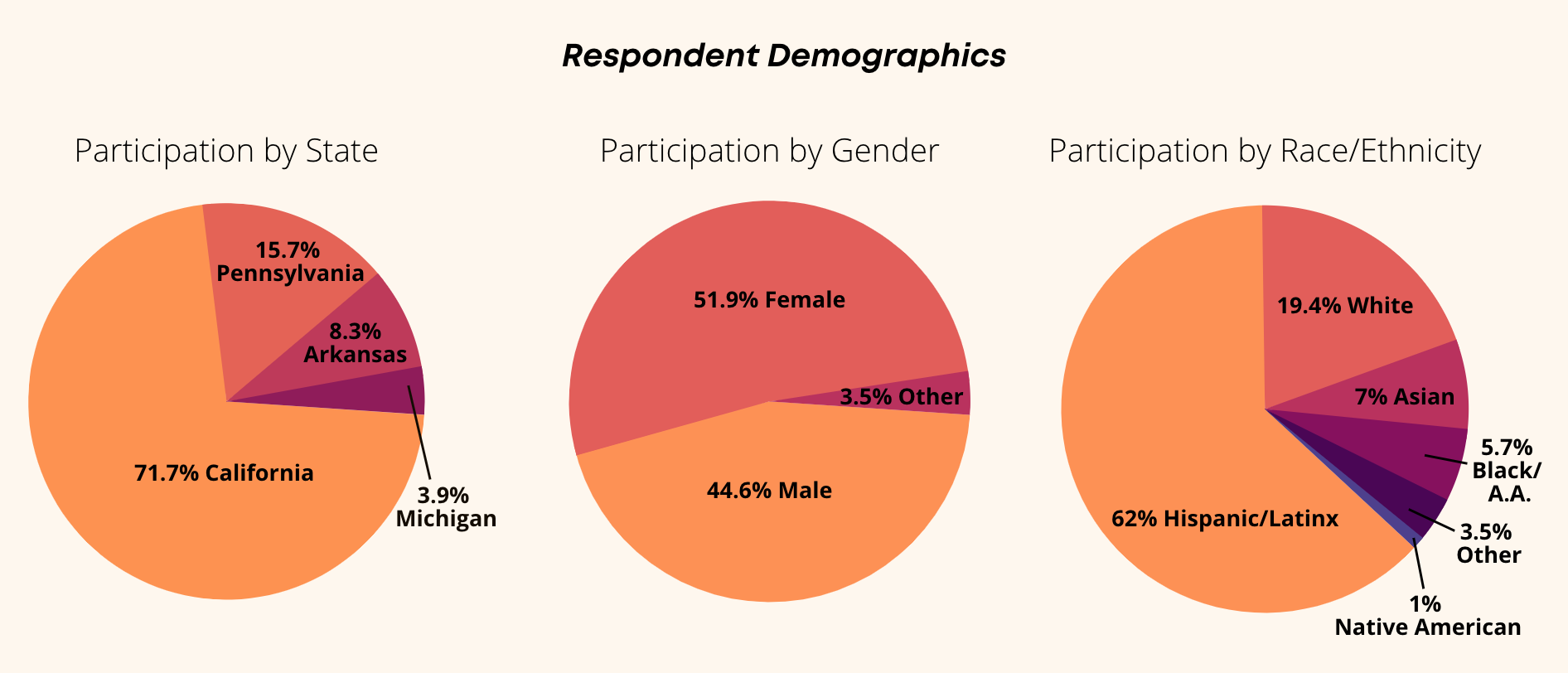

Methodology
Through targeted outreach and recruitment efforts, an invitation to educators, administrators, and counselors was sent late summer through January to recruit individuals and districts interested in participating in the survey. Those who responded were given survey links.
The survey, developed by SDSU Center for Equity and Postsecondary Attainment, built on the work of McKinsey, Strada, New America, and Third Way, who have been conducting surveys throughout the pandemic to understand changing attitudes and patterns of college enrollment. This study utilized a cross-sectional design with a convenience sample for pilot implementation. It was conducted online using SDSU Qualtrics platform.
The online survey was administered to any 12th grade student from a participating school or district during October 2021- March 2022. 1493 students completed the survey. 268 were removed due to completing less than 50% of the survey, 63 were removed because they are not graduating with the Class of 2022. All surveys were confidential, no identifying information was collected and participation was voluntary. The survey took approximately 10-12 minutes to complete and asked questions related to the following topic areas:
- College and career activity participation -virtually or in-person
- Post high school plans
- College and non-college bound
- Pandemic impact on current and future postsecondary plans
- School choice, college costs, confidence in plan
- General pandemic related concerns
- Mental health, job opportunity/security, non-education related costs
Additionally, students responded to open-ended questions:
- What do you wish adults (teachers, parents, school administrators) knew about the high school experience that might help them do their job better?
- Has there been a great experience, an event, or person who was valuable in shaping your post secondary plan?
Our research team examined all emerging observations and used an open-coding method to narrow the study to a set of 10 themes. Individual student responses were sorted using key terms and phrases and designated into one of the 10 themed categories. Not all categories were mutually exclusive (i.e. prepared for college and college pressure), yet our aim was to understand student commentary and maintain the expanse of student feedback. The themes were: College pressure, COVID recovery, Checking in, Feeling unprepared for college, Mental Health, Patience and understanding, Peer pressure and bullying, Real work applications, Stress, and Workload. 437 responses were used in the qualitative analysis.
Results


Of those who reported COVID had either “Significant” or “Some” Impact on their postsecondary decision, they were prompted with a list of concerns regarding COVID and asked how much of a concern it was to them personally. Of all the areas of significant concern, the costs of college - including tuition and room and board, were of the highest concern.

In a similar finding, 21% of students report that their first choice college has changed because of COVID. Of those students whose first choice changed, 48% report that it was because the cost of attendance was too high.
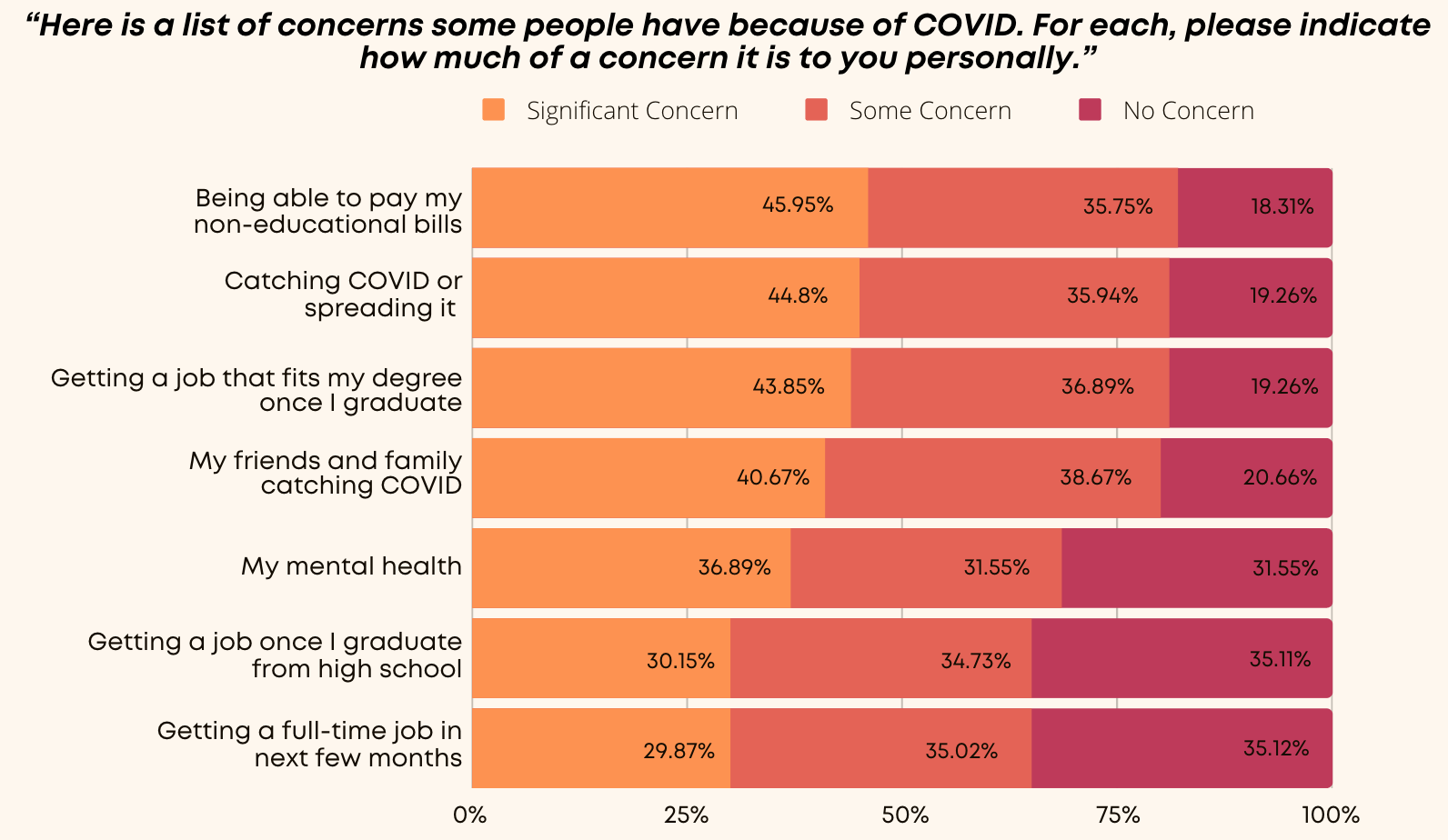
Finally, we asked students “Here is a list of concerns some people have because of COVID. For each, please indicate how much of a concern it is to you personally.” The greatest concern for survey respondents was “Being able to pay my non-education related bills.”

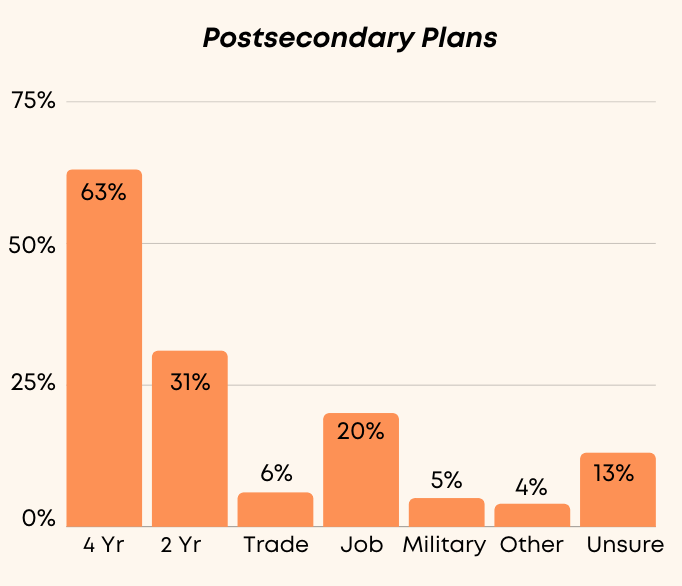

The responses show that 83% of the Class of 2022 plan to enroll in 2- or 4- year colleges after graduation, an additional 3% plan to enroll in a trade or vocational program. Meanwhile 20% plan to work full-time after high school. Over 60% of seniors plan to work full-time AND enroll in 2- or 4- year colleges.
As we look across the pathways, students who selected "4-year college" as their postsecondary plan are less likely to have also selected another pathway- either as a combination of or a sequential step. Whereas, students who selected "Military" as their postsecondary plan were more likely to have selected multiple postsecondary plans besides "Military". The average respondent selected 1.4 postsecondary options.
An average 73% of students report they are “Extremely Sure” or “Very Sure” about their postsecondary plan, which did not increase over time throughout the survey. Students whose pathways included "4- Year" or "Other" had the highest level of confidence in their plan (77%).

Of those who report they are unsure of their plans or do NOT plan to pursue postsecondary education - only 9.6% report that they either (1) do not require college or postsecondary education for their career pathway or (2) plan to enroll in the military. Therefore, 90.4% of students who are unsure of their plans or do NOT plan to pursue postsecondary education are without a certain, viable plan at this stage. 24.1% reported they would wait until graduation to decide. This was followed by 18.8% saying they don't like school and 16.3% saying they don't feel academically prepared.
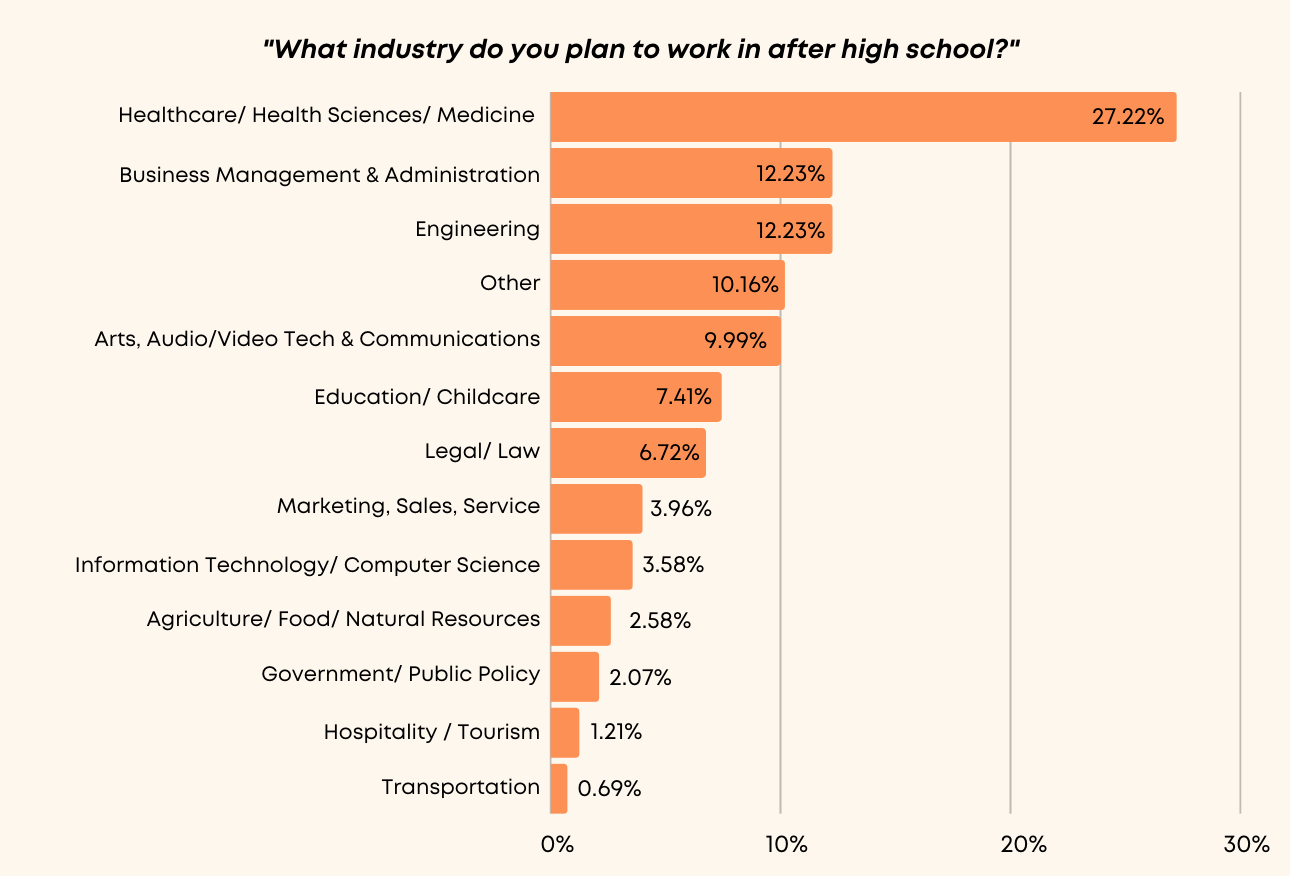
Participants were asked what industry they plan to work in after high school, with a majority (27%) reporting interest in Healthcare/Health Science, followed by Engineering (12.23%) and Business (12.23%).

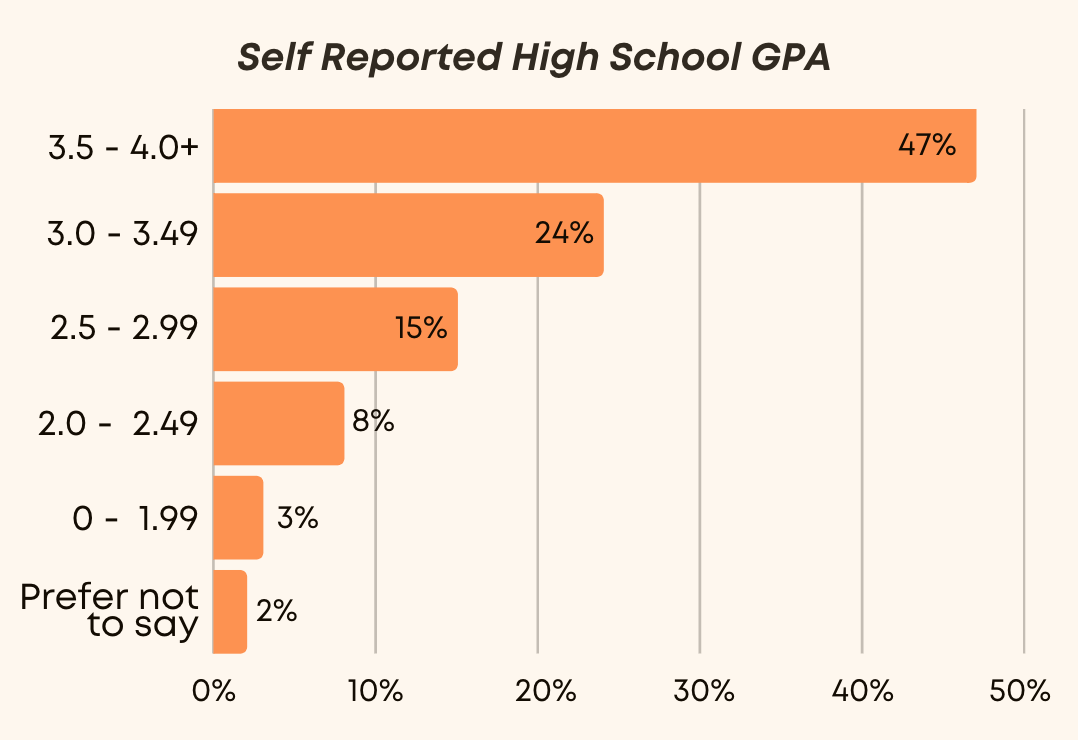

Throughout the data, there was an emerging story of students reporting concerns about high school graduation that was unexpected given that 71% of students reported having a 3.0 GPA or higher, many of whom were in AP/IB courses or enrolled in dual community college courses (63%). And while the respondent group had strong GPAs and high participation rates in college preparation courses, only 10% reported feeling "extremely academically prepared" for college.
This was also evidenced by student comments of not knowing how to be prepared.

The most striking finding was found when broken out by gender subgroups. While men are less academically prepared, based on self reported GPA and participation in college credit coursework, 14% of men report being "extremely academically prepared", compared to women at 7.6%.
Men:
59% participated in college credit courses
65% report a GPA of 3.0+
Women:
67% participated in college credit courses
87% report a GPA of 3.0+

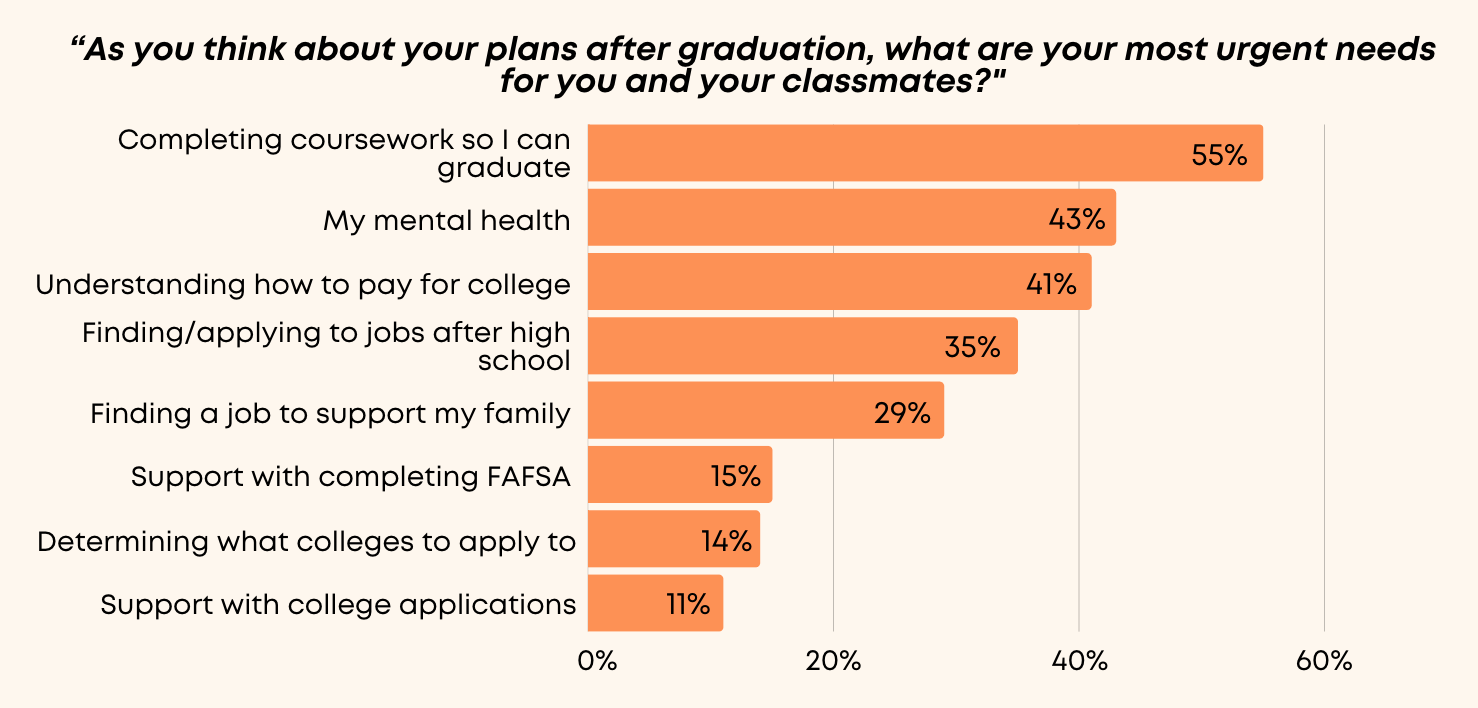
These findings were disquieting for students across all academic levels, especially when the highest reported need was "completing courses so that I can graduate" (494 students). In the qualitative responses there was an overwhelming student response that homework should not be burden, busy work, or ‘packed on’ unnecessarily. Moreover, students report having to take care of family, having job commitments, and being involved in sports- continuing to manage it all during a time of crisis and uncertainty. The responses referenced stress, pressure, mental health concerns, and lack of motivation when referring to workloads.


For students opting to not enroll in postsecondary education or an unsure of their plans after high school, their perspective was also notable. We saw that 18% of students reporting they don’t like school, 16% who don’t feel academically prepared, and 9% who say they have low grades. Thus creating a disenfranchised group of youth.


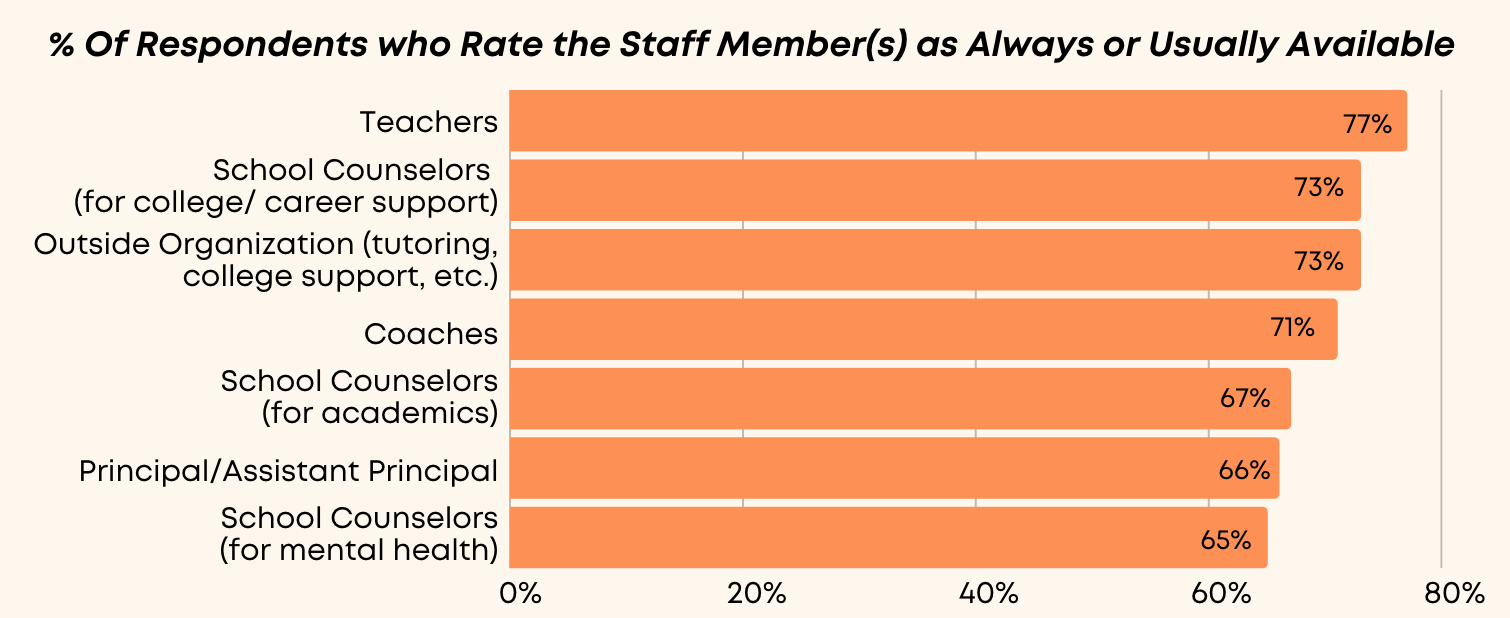
In addition to school counselors, other educators (teachers, coaches and principals) are among the most available staff to school during the pandemic. There is an opportunity to more intentionally engage these staff members in supporting student postsecondary planning. When schools think about the adults who provide postsecondary advising to students, we often focus on counselors and teachers. Yet, the results from the survey are a reminder that there are other staff members who have regular interactions with students and should be included as partners in postsecondary advising, specifically coaches and principals. Coaches (71%) and principals (66%) were consistently in the top group of most accessible staff members during the pandemic.
Additionally, when the results are separated out by the state of the respondent, we see that while outside organizations are the “most available” in California, they do not make the top group for Pennsylvania or Arkansas.
California (71.7% of Survey Respondents)
- Outside Organizations (Tutoring, College Support, Etc.) - 78%
- Teachers - 78%
- School Counselors (for college or career support) - 74%
- Coaches - 70%
Pennsylvania (15.7% of Survey Respondents)
- Teachers - 78%
- Coaches - 77%
- School Counselors (for college or career support) - 70%
- Principal/ Assistant Principal - 68%
Arkansas (8.3% of Survey Respondents)
- Teachers - 77%
- School Counselors (for college or career support) - 74%
- School Counselors (for academic) - 72%
- Coaches - 71%

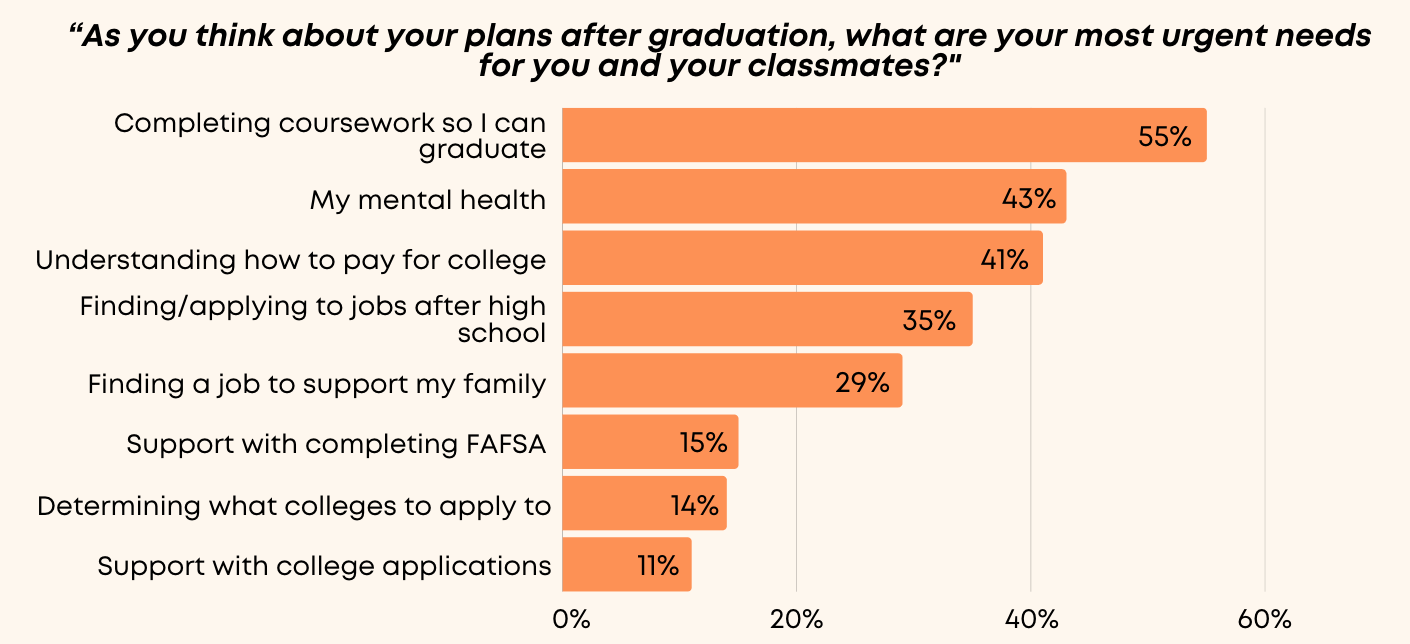
43% of students report that “My mental health” is one of the greatest concerns when asked what are your most urgent needs. Ranking second, under "completing coursework so I can graduate". Which our qualitative responses closely tie mental health issues (anxiety, stress, and lack of motivation) with coursework and the amount of workload students are being given.
Class of 2022 Seniors were asked "What do you wish adults (teachers, parents, school administrators) KNEW about the high school experience that might help them do their job better?" Mental Health was the most commonly represented theme in the qualitative analysis. 94 student responses (22% of all comments) contained a key term or phrases about student mental health.




Student comments with STRESS as a key term or phrase accounted for a close second to mental health, with 93 students reporting; 21% of all comments.



Student comments with WORKLOAD as a key term or phrase accounted for a close third to mental health, with 89 students reporting; 20% of all comments. There was also great overlap between comments about WORKLOAD and mental health, stress, and pressure.


Students are openly sharing the level of mental health concern, stress, and workload expectations as the most important information for adults to know. And it’s not from a lack of working hard or balancing responsibilities, narratives of hundreds of students sharing they are truly trying their best. Yet the level of homework expectation, task completion, test-taking (while online), the ‘piling on the busy work’ are associated with mental health, stress, and work overload. In essence, students are telling the adults to stop with the busy work, give meaningful learning experiences, allow time for enrichment, take it easier on them, and try to understand them more.


What’s interesting is the degree to which students point to mental health as an urgent need and its connection to academics, college preparation, and future planning. This has been a dominant finding amongst the intended measures of determining the COVID impact on postsecondary plans, perceived financial burden, and other COVID variables such as committing to universities that might be online only. Mental and behavioral health, reported with stress, workload, needing patience and understanding, and more was a prominent finding overall. We would be remiss to not be listening wholeheartedly to student voices and recognize that we asked for their thoughts and opinions, they reported loud and clear, and now we need to respond accordingly.
Conclusion
These findings are an indicator of the changing trends of young people towards postsecondary education and career pathways. And while much of the relevant research shows these trends to have existed before the pandemic, the study results are a reminder of necessity to adapt practices, routine mindsets, and educational and racial systemic barriers for underrepresented communities.
We must support students as they explore the myriad of opportunities available to them and THEN consider the postsecondary education necessary to manifest the realization of their dreams for a bright and successful future. We must consider how to dismantle the old systems and work to find new models that are adaptive to how students wish to both work and continue their education. Models that will support students seeking to avoid financial debt as a requirement to successfully progress through college, and do not put rigid barriers on requirements of full time enrollment, daytime courses, and having the ‘college experience’. We are beginning to more fully understand the unique challenges faced by each high school graduating class and their needs.
Students are pushing back on the long standing “college for all” message that silenced the realities and circumstances that low income and marginalized students experience navigating an educational system that has privileged the wealthy and elite, while problematizing the students who were intentionally left behind. Students are drawing attention to the need for nuanced advising practices that recognize and center historically marginalized student and parent voices, celebrate inclusive practices that seek input from all community members, understand nontraditional pathways, and recognize funding remains a substantial barrier for many students. In combination with student mental and behavioral health concerns, postsecondary advising must address all of this in a holistic approach- not a segmented process.
Follow the Center for Equity and Postsecondary Attainment (CEPA) through our website, blog, social media, and sign up for our listserve to access up to date practitioner resources, tools, and tips to create an inclusive, equity driven postsecondary advising space, one that does not create binary choices, but is student centered and inclusive of multiple concurrent options.
Reference
Hanson, M. (2022, July 29). Student loan debt statistics. EducationData.org. https://educationdata.org/student-loan-debt-statistics